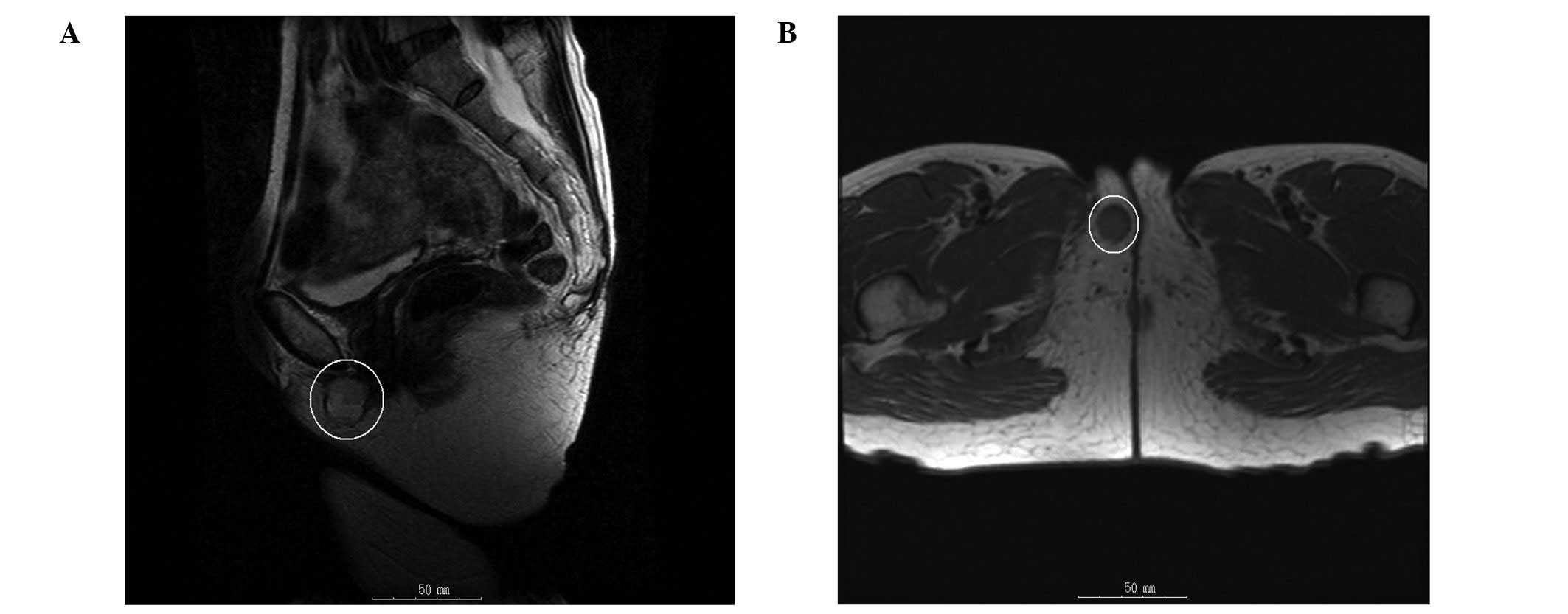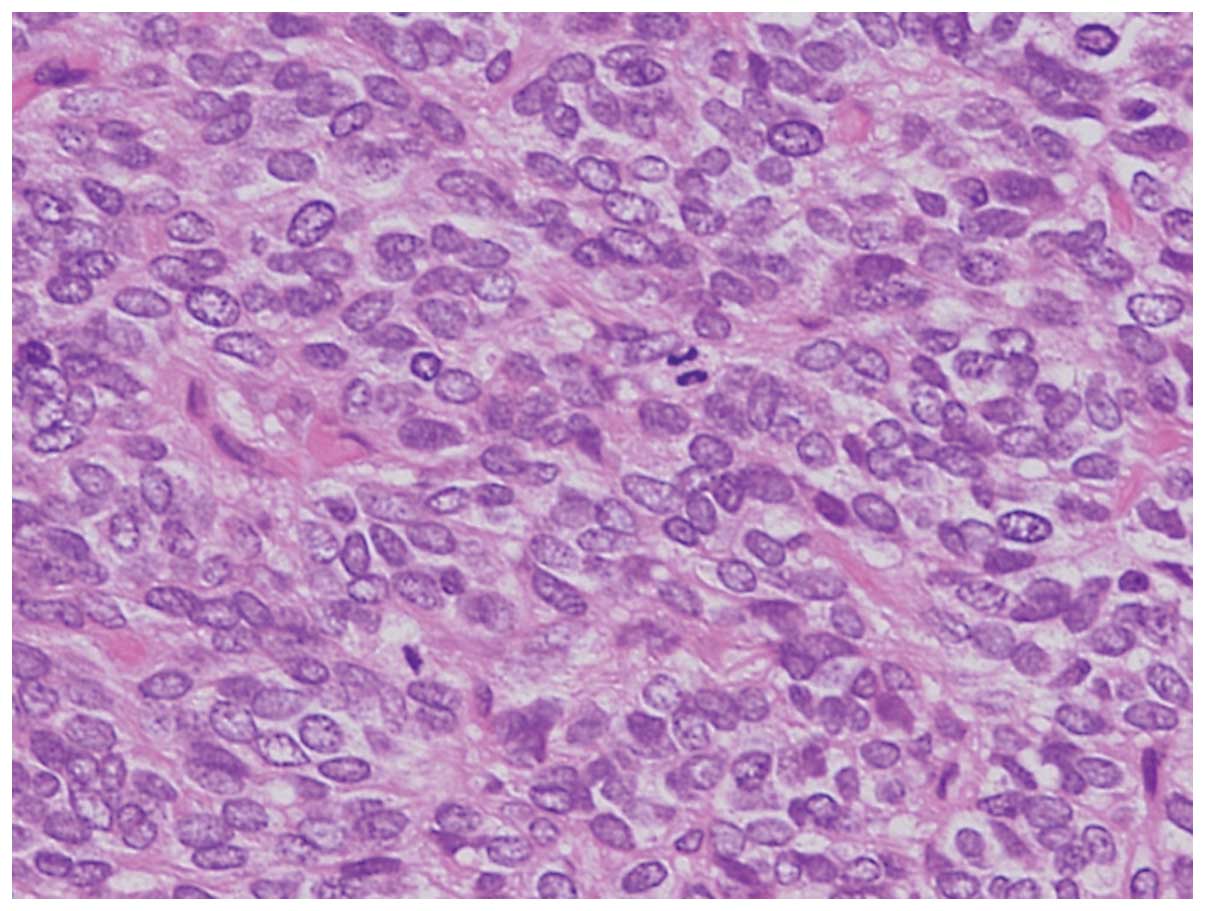Primitive neuroectodermal tumor originating in the vulva: A case report
- Authors:
- Makiko Matsuda
- Tomoyuki Ichimura
- Mari Kasai
- Makoto Murakami
- Manabu Hoshi
- Naoki Kawamura
- Toshiyuki Sumi
-
View Affiliations
Affiliations: Department of Obstetrics and Gynecology, Osaka City University Graduate School of Medicine, Osaka 545‑8585, Japan, Department of Obstetrics and Gynecology, Osaka City Sumiyoshi Hospital, Osaka 559-0012, Japan, Department of Orthopedic Surgery, Osaka City University Graduate School of Medicine, Osaka 545‑8585, Japan, Department of Obstetrics and Gynecology, Osaka City General Hospital, Osaka 534-0021, Japan
- Published online on: April 16, 2014 https://doi.org/10.3892/ol.2014.2073
-
Pages:
187-189
Metrics:
Total
Views: 0 (Spandidos Publications: | PMC Statistics:
)
Metrics:
Total PDF Downloads: 0 (Spandidos Publications: | PMC Statistics:
)
This article is mentioned in:
Abstract
Primitive neuroectodermal tumors (PNETs) exhibit chromosomal translocations in common with those of Ewing's sarcoma. They usually originate in bone or soft tissue but rarely arise in the vulva. The current case report presents a case of PNET originating in the vulva in a 60‑year‑old female, who previously underwent enucleation of a vulvar tumor in another hospital. The pathologist suspected a histopathological diagnosis of PNET, and simple vulvectomy and resection of the inguinal lymph nodes were performed. An ~3 cm mass recurred in the right side of the vulva four years following the initial surgery and the tumor was excised. The tumor comprised small, round‑to‑oval nuclei and stained positively for MIC‑2, synaptophysin, neuron‑specific enolase and neurofilament antibodies. To date, the patient remains alive and with no evidence of disease four years following multidisciplinary treatment, despite PNETs usually exhibiting a poor prognosis. This is due to the small tumor size and the absence of distant metastasis.
View References
|
1
|
Hart NH and Earle KM: Primitive
neuroectodermal tumors of the brain in children. Cancer.
32:890–897. 1973.
|
|
2
|
Stout AP: A tumor of the ulnar nerve. Proc
NY Pathol Soc. 18:2–12. 1918.
|
|
3
|
Chen L: Primitive neuro ectodermal tumor
of the uterus. Arch Histopathol D D. 16:33–36. 2009.
|
|
4
|
Fischer G, Odunsi K, Lele S and Mhawech P:
Ovarian primary primitive neuroectodermal tumor coexisting with
endometrioid adenocarcinoma: a case report. Int J Gynecol Pathol.
25:151–154. 2006.
|
|
5
|
Halil S, Kucuk M, Arvas M, et al:
Peripheral primitive neuroectodermal tumor (PNET) of the vulva: a
case report. Eur J Gynaecol Oncol. 32:117–118. 2011.
|
|
6
|
Scherr GR, d’Ablaing G III and Ouzounian
JG: Peripheral primitive neuroectodermal tumor of the vulva.
Gynecol Oncol. 54:254–258. 1994.
|
|
7
|
Takeshima N, Tabata T, Nishida H, et al:
Peripheral primitive neuroectodermal tumor of the vulva: report of
a case with imprint cytology. Acta Cytol. 45:1049–1052. 2001.
|
|
8
|
McCluggage WG, Sumathi VP, Nucci MR, et
al: Ewing family of tumors involving the vulva and vagina: report
of series of four cases. J Clin Pathol. 60:674–680. 2007.
|
|
9
|
Fong YE, López-Terrada D and Zhai QJ:
Primary Ewing sarcoma/peripheral primitive neuroectodermal tumor of
the vulva. Hum Pathol. 39:1535–1539. 2008.
|
|
10
|
Dehner LP: Primitive neuroectodermal tumor
and Ewing’s sarcoma. Am J Surg Pathol. 17:1–13. 1993.
|
|
11
|
de Alava E and Gerald WL: Molecular
biology of the Ewing’s sarcoma/primitive neuroectodermal tumor
family. J Clin Oncol. 18:204–213. 2000.
|
|
12
|
Dagher R, Pham TA, Sorbara L, et al:
Molecular confirmation of Ewing sarcoma. J Pediatr Hematol Oncol.
23:221–224. 2001.
|
|
13
|
Iwamoto Y: Diagnosis and treatment of
Ewing’s sarcoma. Jpn J Clin Oncol. 37:79–89. 2007.
|
|
14
|
Esiashvili N, Goodman M and Marcus RB Jr:
Changes in incidence and survival of Ewing sarcoma patients over
the past 3 decades: Surveillance Epidemiology and End Results data.
J Pediatr Hematol Oncol. 30:425–430. 2008.
|
|
15
|
Jain S and Kapoor G: Chemotherapy in
Ewing’s sarcoma. Indian J Orthop. 44:369–377. 2010.
|
|
16
|
Tanaka K, Matsunobu T, Sakamoto A, Matsuda
S and Iwamoto Y: High-dose chemotherapy and autologous peripheral
blood stem-cell transfusion after conventional chemotherapy for
patients with high-risk Ewing’s tumors. J Orthop Sci. 7:477–482.
2002.
|
|
17
|
Rodriguez-Galindo C, Billups CA, Kun LE,
et al: Survival after recurrence of Ewing tumors: the St. Jude
Children’s Research Hospital experience, 1979–1999. Cancer.
94:561–569. 2002.
|











